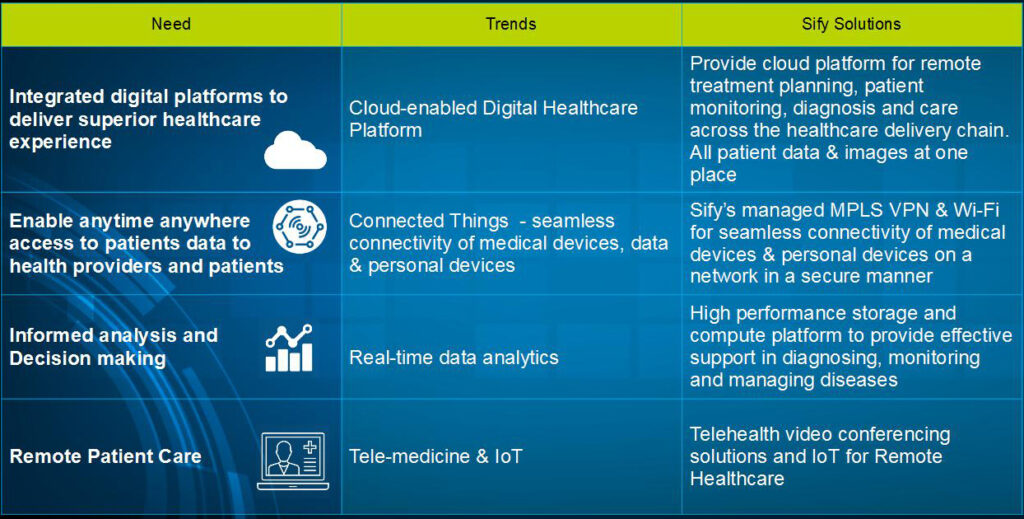Cloud Driving Transformation in the Healthcare Sector
The “Sify: Power Discussion” hosted at the “Healthcare Senate & Healthcare Information Technology Summit 2017” organised by the Indian Express Group and Sify Technologies discussed the various benefits that cloud can bring to the Indian healthcare sector.
The CXOs who participated in the power discussion hosted by Sify shared their challenges in the ICT space and subsequently, various views were shared by the panellists and Sify on how the cloud technology can solve their pain points and finally help in building better patient experience.
Summary of Challenges
- Increasing Data volumes is becoming unmanageable in preserving, optimising and retrieval of data. The Cost associated with that is also an issue.
- Can IT play a role in reducing the time of the patient in “Check-in / Checkout/ Post Checkout Care”?
- Challenges in the Inter-departments users of IT systems at the hospitals. For example, the HIS at times hasn’t been successful in reducing the pain points of the doctors with Care Teams.
- Disparate IT systems do not talk to each other and are not compatible, so there should be a common platform that allows different technologies to work seamlessly.
- Hospitals should prioritise in terms of what they want to achieve and accordingly how IT can play a role. At times, the perception is that IT has a magic wand, and any problem in hospital, IT is made a scapegoat.
The Case for Cloud Computing
Anindya Sen, Transformation – Evangelist, Sify Technologies, spoke extensively on how cloud can solve various challenges faced not only by the IT function but also the functions in the hospitals. He started with a specific example of the cloud implementation for the radiology department at Cancer Treatment Services International (CTSI). In each of the twelve CTSI hospitals, which were hitherto running on separate IT systems, were now completely moved on cloud. The data was now directly fed to the radiology departments of these twelve hospitals. It helped radiologists to serve the patients by doing targeted radiation.
One of the panellists asked about how cloud can reduce cost for the organisations. Cloud can significantly slash costs for companies who want to serve multiple locations using the cloud technology, however, the cost advantage might not fructify if it were a single location. Nevertheless, the benefits of cloud beyond cost parameters only were discussed for such scenarios.
A specific discussion happened in terms of healthcare industry where in spite of adopting Cloud, the IT team still has a task at hand in managing end points, their networking, etc. Network-as-a-service, a relevant example in this case was discussed to take the pain away from internal network management. Sify has provided “Network as a service” to many companies having a wide geographical presence using the cloud model.
The panellists were of the consensus that different components of IT like networks, applications, different patient systems etc. on cloud hosted by a single CSP, who partners with different domain experts and partners can unleash the potential that cloud can offer.
Sify explained a case study of Uttar Pradesh Power Corporation Ltd (UPPCL). Sify has hosted the IT infrastructure, end-to-end on cloud, partnering with the right domain experts and service providers for the various components of the IT infrastructure be it network, security, antivirus etc. The customer pays Sify on “Per Bill generated i.e. Outcome Based Model”.
With this model, the role of the CIO will focus not on “Switch on – Switch off issues” but concentrate on the Innovation, Patient Experience, Improve Inter-Departmental Coordination, Post Checkout Patient Care, etc. Various other models like per bed, per patient were also deliberated.
There is also a lot of potential waiting to be tapped in the on-premise cloud space. On premise cloud fits well with organizations having large IT resources in-house. IT and FMCG companies are a nice fit. Sify provides their infrastructure and services to these companies. This model was suggested by panel members specifically for concentrated IT landscapes.
With global issues like Global warming, floods are becoming more frequent and thus the availability of systems can get affected. One of the panellists spoke about how during the Chennai floods, because the systems were hosted in one place in Chennai, the hospitals in other cities were affected however in one of the similar instances of floods, this was avoided because now the systems were working on cloud. This brings in the case for DR as a service. Cloud can also be helpful in bringing innovation in IT processes.

The Potential of Telemedicine
Telemedicine has not been able to take off in India and the reasons to which were discussed. Various suggestions on how telemedicine can be made more reasonable for the medical community and patients alike.
One of the reasons, as a panellist claimed, that was not allowing telemedicine to take off is there is no certainty on who will bear the cost. It works for the government, who pays for it entirely however for private hospitals, there is no business model.
Notwithstanding, telemedicine can be useful for patient scheduling, touchpoints, delivering care and administration process. There was also a broad consensus that telemedicine can be tremendously beneficial for secondary care i.e. once the patient has visited the doctor personally and his case is well understood by the doctor, the patient need not visit him the next time.
The treatment can happen using telemedicine unless it is necessary for an in-person visit. So the school of thought in the healthcare industry about the necessity to give the touch and feel for the patient is reducing and is a myth. With IoT technologies, the medical devices are also getting connected and this can be a contributing factor for the emergence of telemedicine in India.
Conclusion
On the whole, it was a good participative discussion where the various points of view from the Business side, IT side and the service provider angle were discussed. Obstacles as well as advantages for adopting an agile cloud based model were deliberated upon and a need for business outcome based model to help IT and business alike was unanimously agreed upon.
New technologies and solutions – such as mobile apps, cloud computing, the Internet of Things, and analytics – are available to make healthcare organizations more accessible, simpler, faster, and more cost effective.
Whether you represent a hospital, clinic, or specialist, Sify has a variety of scalable, agile, and secure solutions to help your organization achieve these goals.
Delegate Participants:
- Manoj Kumar (Apollo Health & Lifestyle )
- Santosh Patil (Asian Cancer Institute)
- Dilip Ramdasan (Dr. Agarwals Eye Hospital)
- Nallamuthu Sivaraj (Gem Hospital)
- Rajesh Kumar Gupta (Medanta – The Medicity)
- Jai Prakash Dwivedi (Rajiv Gandhi Cancer Institute & Research Centre)
- Ramesh Desai (Sagar Hospitals – Banashankari)
- Sachin P Marathe (Sapphire Hospitals)
- Niranjan Kumar Ramakrishnan (Sir Ganga Ram Hospital )
- Maneesh Agarwal (Apollo Hospitals)
- T S Mohan Kumar (Brindhavvan Areion Hospitals)
- Kvs Sesha Reddy (Brindhavvan Areion Hospitals )
- Ashim Kumar (CARE Hospital)
- Selwyn Colaco (Cytecare Cancer Hospitals )
- Naveen Nagar (HCG )
- Manisha Pal (Hiranandani Hospital)
- Paritosh Joshi (Kasturba Vaidyakiya Rahat Mandal)
- M. S Guru Prasad (Narayana Health )
- Manoj Chavan (Sir HN Reliance Foundation Hospital & Research Center )
Sify Participants:
- Subramaniam Ramakrishnan
- Anindya Sen
- Sonia Kaul
- Sanjay Gour
- Sagar Pattnaik
- Abhinav Gupta
Traditional vs VoIP- What’s best for your business?
As more and more businesses, both big and small, are jumping on the VoIP (Voice over IP) bandwagon, it is interesting to examine what is causing this exodus from the traditional alternative of PSTN (Public Switched Telephone Network) including Mobiles and Landlines.
In order to understand the reasons for the switch, it is important to first appreciate what is significant for these businesses while opting for a communication system. The chief concerns for businesses, irrespective of their size, while choosing a network are,
- How to reduce costs and at the same time not compromise on the quality of the communication system.
- Is there a way that would improve communication with customers and employees and better connect them?
- How to achieve more value for your money and get additional features at the same cost.
- Can the communication system contribute to an increase in efficiency and productivity?
As VoIP addresses these concerns and provides a powerful tool for businesses to ‘up their game’, enterprises in increasing numbers are opting for this alternative.
Cost-Effective Choice
A VoIP solution has a definite edge over its PSTN alternative as it offers free CUG (VoIP-to-VoIP) calling for both local and international. The calls made to mobile and landline phones through VoIP have nominal subscription fees as against a much more expensive PSTN alternative. The sound quality is continually improving as the technology is evolving, providing superior communications and better filtering of background noise with VoIP. Its online conferencing and other features help reduce the requirement for travel. It also has a lesser bandwidth requirement (10 Kbps) than the PSTNs (64 Kbps).
Improve Communication with Customers and Employees
VoIP provides unified communication, helping the employees to work remotely from any place with an Internet connection and ‘take the office’ with them. It also provides the ‘presence’ technology that enables users to see if employees are available and accordingly get in touch with them. PSTNs on the other hand, are able to provide the remote extension facility only with dedicated lines for each extension and hence are very expensive.
More Value for Money
VoIP solution provides an ease of scalability without adding significant infrastructure and cost to the decision. Additionally, VoIP offers call waiting, call forwarding and call transfer options as a standard offering, but the same is available in PSTNs at an additional cost.
Increased Efficiency and Productivity
VoIP has an edge over its traditional counterpart as it allows businesses to get enterprise class software at an affordable cost. As the cost of scalability is low, even smaller businesses can enjoy customized solutions with many features as standard or as an affordable add-on. These lead to increased productivity, less down time, and hence more profit. However, as the service terminates when the Internet connectivity (power) is lost, organizations must have a VoIP backup plan. PSTNs, nevertheless, are able to continue service during power outages, as phone jacks do not require electricity.
Hence, traditional choices such as PSTNs are making way for VoIP as the latter are proving themselves as a powerful tool, giving the businesses a competitive edge and providing the ‘right-size’ technology at an affordable price.
As India’s first ICT Company to be listed on NASDAQ, Sify has years of experience in providing reliable and secure Network Integration services to enterprises across industry verticals.
Our cutting-edge networking services ensure reliable data connectivity services as well as the best-in-class Voice services in India – all available as the cost effective payment models aligned to scale with the growing needs of individual businesses.



























































